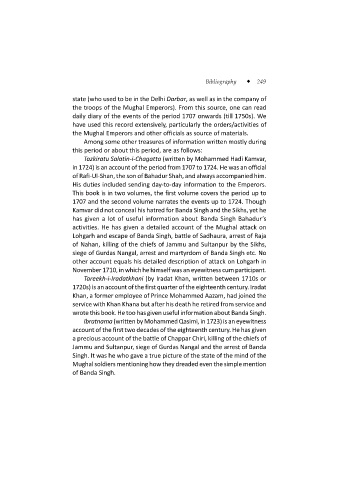Page 249 - Lohgarh
P. 249
Bibliography w 249
state (who used to be in the Delhi Darbar, as well as in the company of
the troops of the Mughal Emperors). From this source, one can read
daily diary of the events of the period 1707 onwards (till 1750s). We
have used this record extensively, particularly the orders/activities of
the Mughal Emperors and other officials as source of materials.
Among some other treasures of information written mostly during
this period or about this period, are as follows:
Tazkiratu Salatin-i-Chagatta (written by Mohammed Hadi Kamvar,
in 1724) is an account of the period from 1707 to 1724. He was an official
of Rafi-Ul-Shan, the son of Bahadur Shah, and always accompanied him.
His duties included sending day-to-day information to the Emperors.
This book is in two volumes, the first volume covers the period up to
1707 and the second volume narrates the events up to 1724. Though
Kamvar did not conceal his hatred for Banda Singh and the Sikhs, yet he
has given a lot of useful information about Banda Singh Bahadur’s
activities. He has given a detailed account of the Mughal attack on
Lohgarh and escape of Banda Singh, battle of Sadhaura, arrest of Raja
of Nahan, killing of the chiefs of Jammu and Sultanpur by the Sikhs,
siege of Gurdas Nangal, arrest and martyrdom of Banda Singh etc. No
other account equals his detailed description of attack on Lohgarh in
November 1710, in which he himself was an eyewitness cum participant.
Tareekh-i-Iradatkhani (by Iradat Khan, written between 1710s or
1720s) is an account of the first quarter of the eighteenth century. Iradat
Khan, a former employee of Prince Mohammed Aazam, had joined the
service with Khan Khana but after his death he retired from service and
wrote this book. He too has given useful information about Banda Singh.
Ibratnama (written by Mohammed Qasimi, in 1723) is an eyewitness
account of the first two decades of the eighteenth century. He has given
a precious account of the battle of Chappar Chiri, killing of the chiefs of
Jammu and Sultanpur, siege of Gurdas Nangal and the arrest of Banda
Singh. It was he who gave a true picture of the state of the mind of the
Mughal soldiers mentioning how they dreaded even the simple mention
of Banda Singh.

